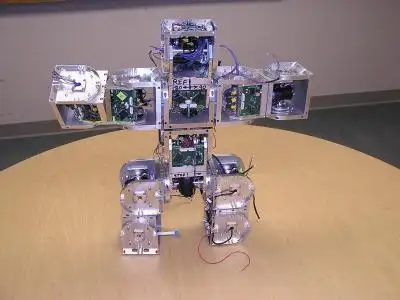Modular robotics also known as mod-robots or mod-robotics is revolutionizing various industries by offering flexible, adaptive, and scalable robotic solutions. These systems consist of multiple, interchangeable modules that can reconfigure themselves to perform diverse tasks, thereby enhancing efficiency and reducing downtime. This comprehensive guide delves into the intricacies of mod-robotics, their applications, and future potential.
See: Will AI and Robotics Take Over Human Jobs in 2030?
Key Components of Modular Robotics
Modular Units
Modular units are the building blocks of mod-robotics. Each unit is a self-contained module equipped with its own sensors, actuators, and control mechanisms. These units can operate independently or collectively, forming complex robotic systems capable of executing sophisticated tasks.
Connectivity and Communication
Seamless connectivity and communication between modules are critical for the functionality of mod-robotics. Advanced communication protocols and network systems enable real-time data exchange, synchronization, and collaborative operation among the modules.
See Also: Top 10 Robotic Machines to Invest in Today as a Manufacturing Company
Control Systems
The control systems in mod-robotics are designed to manage and coordinate the activities of individual modules. These systems utilize advanced algorithms and artificial intelligence to optimize the performance and adaptability of the robotic system.
Applications of Modular Robotics
Manufacturing with Modular Robotics
In the manufacturing sector, mod-robotics enhances productivity and flexibility. These robots can be reconfigured to perform various tasks such as assembly, welding, and material handling, adapting to different production requirements with minimal downtime.
Healthcare with Modular Robotics
Modular robotics is making significant strides in healthcare, particularly in surgical procedures and rehabilitation. These robots offer precision, reliability, and the ability to customize configurations for specific medical tasks, improving patient outcomes and operational efficiency.
Extra: Robots vs. AI: Which is a Better Investment in 2025?
Space Exploration with Modular Robotics
Space exploration demands versatile and resilient robotic systems. Modular robots, with their adaptability and reconfigurability, are ideal for performing a wide range of tasks in space missions, from assembly and maintenance of spacecraft to exploration of extraterrestrial surfaces.
Disaster Response with Modular Robotics
In disaster response scenarios, modular robotics provides invaluable assistance. These robots can navigate challenging environments, carry out search and rescue operations, and perform tasks that are too dangerous for human responders, thereby saving lives and reducing risks.
Types of Modular Robotics
Chain-Type Modular Robots
Overview
Chain-type modular robots consist of serially connected modules, resembling the links of a chain. Each module typically has a limited range of motion, but when combined, they can achieve complex movements and configurations.
Applications
- Inspection and Maintenance: Used in pipeline inspection and maintenance tasks due to their ability to navigate through confined spaces.
- Search and Rescue: Effective in search and rescue operations where the terrain is unpredictable and challenging.
Lattice-Type Modular Robots
Overview
Lattice-type modular robots are composed of units arranged in a grid or lattice structure. These robots can reconfigure themselves by attaching and detaching modules, allowing them to adapt to different shapes and functions.
Applications
- Construction: Ideal for building temporary structures and scaffolding.
- Space Exploration: Useful in assembling and maintaining space structures due to their high adaptability.
Hybrid Modular Robots
Overview
Hybrid modular robots combine elements of both chain-type and lattice-type robots. They can operate as individual units or in connected configurations, offering a balance between flexibility and structural stability.
Applications
- Medical Applications: Employed in minimally invasive surgeries where precise control and adaptability are essential.
- Industrial Automation: Used in manufacturing processes requiring both flexibility and strength.
Mobile Modular Robots
Overview
Mobile modular robots consist of autonomous modules capable of individual movement. These robots can collaborate to form larger structures or perform tasks that require collective effort.
Applications
- Logistics and Warehousing: Utilized in automated warehouses for transporting goods and organizing inventory.
- Agriculture: Deployed in agricultural fields for tasks such as planting, harvesting, and monitoring crops.
Self-Reconfigurable Modular Robots
Overview
Self-reconfigurable modular robots can autonomously change their configuration to adapt to different tasks and environments. These robots use advanced algorithms to determine the optimal configuration for each task.
Applications
- Exploration and Surveying: Employed in exploration missions where the environment is unknown and variable.
- Defense and Military: Used in military applications for reconnaissance and logistics in diverse terrains.
Advantages of Modular Robotics
Flexibility
The inherent flexibility of modular robotics allows for easy reconfiguration and adaptation to various tasks and environments. This versatility significantly enhances the efficiency and utility of robotic systems across different applications.
Scalability
Modular robotics offers unparalleled scalability. Additional modules can be integrated seamlessly into existing systems, expanding their capabilities and allowing for the development of more complex and robust robotic solutions.
Cost-Effectiveness
By utilizing interchangeable modules, modular robotics reduces the need for multiple specialized robots, leading to significant cost savings. The ability to reconfigure modules for different tasks further optimizes resource utilization and reduces operational expenses.
Future Prospects of Modular Robotics
Advancements in Artificial Intelligence
The integration of advanced artificial intelligence (AI) with modular robotics promises to unlock new levels of autonomy and intelligence. AI-driven modular robots will be capable of learning from their environments, making autonomous decisions, and performing increasingly complex tasks.
Innovations in Material Science
Future developments in material science will enable the creation of more durable, lightweight, and efficient modular units. These innovations will enhance the performance, reliability, and versatility of mod-robotics systems, expanding their potential applications.
Enhanced Human-Robot Collaboration
As modular robotics evolves, the focus on human-robot collaboration will intensify. Advanced interfaces and control mechanisms will facilitate seamless interaction between humans and robots, improving safety, efficiency, and productivity in various industries.
Mod-Robotics Diagram

Conclusion
Modular robotics represents a paradigm shift in robotic technology, offering unparalleled flexibility, scalability, and cost-effectiveness. With ongoing advancements in AI and material science, the future of mod-robotics is poised to transform numerous industries, from manufacturing and healthcare to space exploration and disaster response. As these systems continue to evolve, their impact on productivity, safety, and innovation will be profound, heralding a new era of robotic capabilities and applications.











